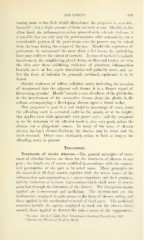Page 491 - My FlipBook
P. 491
; ;
TREATMENT. 489
sentiiig none or but little febrile disturbance the prognosis is, as a rule,
favorable ; but a slight amount of tissue necrosis occurs. Should, on the
other hand, the inflammatory action proceed with volcanic violence, it
is possible that not only may the pericementum suffer extensively, but a
considerable p from the bone during the escape of the pus. Should this separation of
periosteum be maintained for more than a few hours, the underlying
bone may suffer to the extent of necrosis. In case of marked lymphatic
involvement, the neighboring glands being sM'ollen and tender, or even
the skin over them exhibiting evidences of glandular inflammation
beneath, more or less septic intoxication will probably occur, and un-
less the focus of infection be promptly sterilized, septicemia is to be
feared.
Should evidences of diffuse cellulitis occur, indicating the invasion
"
of streptococci into the adjacent soft tissues, it is a danger signal of
threatening pyemia.' Heath" records a case of oedema of the glottis due
to the involvement of the connective tissues about the glottis in the
oedema accompanying a devek)ping abscess upon a lower molar.
The })rognosis is good in a vast majority percentage of cases, when
the offending tooth is extracted early in tlie attack, or at its height
still the prognosis
this applies even with apparently very grave cases ;
as to the retention of the affected tooth is also very good, unless the
abscess run a phagedenic course. In many of the cases of chronic
abscess having a distant discharge the abscess may be cured and the
tooth retained. Other cases obstinately refuse to heal so long as the
offending tooth is present.
Treatment.
Treatment of Acute Abscess.—The general principles of treat-
ment of alveolar abscess are those for the treatment of abscess in any
part ; the details are of course modified in accordance with the anatom-
ical peculiarities of the part to be acted upon. These principles are
the removal of all dead matter, together with the active causes of the
inflammation and suppuration, /. e. micro-organisms and their products,
and the induction of a tissue regeneration which shall serve to restore
parts lost through the formation of the abscess. The therapeutic means
applied are instrumental and medicinal. The instrumental are the
instruments employed to gain access to the focus of disease action, and
those applied in the mechanical removal of dead parts. The medicinal
measures include the agents employed to wash out the abscess tract
second, those applied to destroy the active causes of the suppuration
;
^ See case— Dr. E. C. Kirk, Proc. Odontological Society of Pennsylvania, 1892.
" Injuries and Diseases of the Jaws, 3d ed.
TREATMENT. 489
sentiiig none or but little febrile disturbance the prognosis is, as a rule,
favorable ; but a slight amount of tissue necrosis occurs. Should, on the
other hand, the inflammatory action proceed with volcanic violence, it
is possible that not only may the pericementum suffer extensively, but a
considerable p
periosteum be maintained for more than a few hours, the underlying
bone may suffer to the extent of necrosis. In case of marked lymphatic
involvement, the neighboring glands being sM'ollen and tender, or even
the skin over them exhibiting evidences of glandular inflammation
beneath, more or less septic intoxication will probably occur, and un-
less the focus of infection be promptly sterilized, septicemia is to be
feared.
Should evidences of diffuse cellulitis occur, indicating the invasion
"
of streptococci into the adjacent soft tissues, it is a danger signal of
threatening pyemia.' Heath" records a case of oedema of the glottis due
to the involvement of the connective tissues about the glottis in the
oedema accompanying a devek)ping abscess upon a lower molar.
The })rognosis is good in a vast majority percentage of cases, when
the offending tooth is extracted early in tlie attack, or at its height
still the prognosis
this applies even with apparently very grave cases ;
as to the retention of the affected tooth is also very good, unless the
abscess run a phagedenic course. In many of the cases of chronic
abscess having a distant discharge the abscess may be cured and the
tooth retained. Other cases obstinately refuse to heal so long as the
offending tooth is present.
Treatment.
Treatment of Acute Abscess.—The general principles of treat-
ment of alveolar abscess are those for the treatment of abscess in any
part ; the details are of course modified in accordance with the anatom-
ical peculiarities of the part to be acted upon. These principles are
the removal of all dead matter, together with the active causes of the
inflammation and suppuration, /. e. micro-organisms and their products,
and the induction of a tissue regeneration which shall serve to restore
parts lost through the formation of the abscess. The therapeutic means
applied are instrumental and medicinal. The instrumental are the
instruments employed to gain access to the focus of disease action, and
those applied in the mechanical removal of dead parts. The medicinal
measures include the agents employed to wash out the abscess tract
second, those applied to destroy the active causes of the suppuration
;
^ See case— Dr. E. C. Kirk, Proc. Odontological Society of Pennsylvania, 1892.
" Injuries and Diseases of the Jaws, 3d ed.


